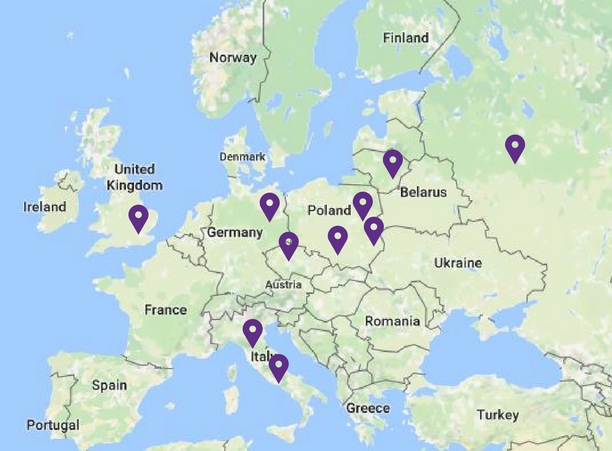
This summer, 59 students jet set to different locations around the world through the College’s ever-popular Maymester program to sites in England, Italy, Poland, Lithuania, Czech Republic, Germany, and Russia. Each year, the College offers a number of these summer study abroad programs for students, ranging from four to six weeks in length, where students take a course led by Holy Cross faculty for credit. Students participate in enriching cultural excursions aimed to complement and enhance their academic experience abroad.
Take a look at where our students went this summer.
London, England
 Students visited many museums and galleries in addition to theatre productions in London. Image by Alisha Collazo ’18
Students visited many museums and galleries in addition to theatre productions in London. Image by Alisha Collazo ’18Number of students: 8
Faculty: Edward Isser, chair and professor of theatre
Program Details: In just four weeks, students saw 30 theatrical productions—from main stage productions in the West End to experimental productions on the Fringe. The students’ experience with some of the world’s finest theatrical work was augmented by their exploration of London’s many museums, galleries, and concert halls, its architecture and people. The Maymester also included day trips to Stratford-upon-Avon, Oxford, and Greenwich.
Highlights: “Prior to this trip, I have never traveled internationally so everything was a new experience for me. Our schedule was filled every week day; I loved it! We heard two symphonies, visited many art exhibits, went to what felt like every museum in London, and took every scenic route possible. We saw Buckingham Palace, visited the Houses of Parliament, and even got lost roaming the streets near Waterloo Station looking for Professor Ed’s favorite chocolate cake.” – Alisha Collazo ’18
Takeaway: “My greatest take away from the month of theatre was a real appreciation for the what theatre can do that no other art can accomplish. The incredibly creative and beautiful ways that stories are portrayed can be hard to appreciate until you see so many different and varied types of examples in a row.
“My expectation from the trip was to be bombarded with culture and come back an encyclopedia of the moment when it came to British theatre. What actually happened was very different. The trip was more of a crash course in learning how to even look at art through a modern lens.” – Matthew Freije ’19
Tuscany, Italy
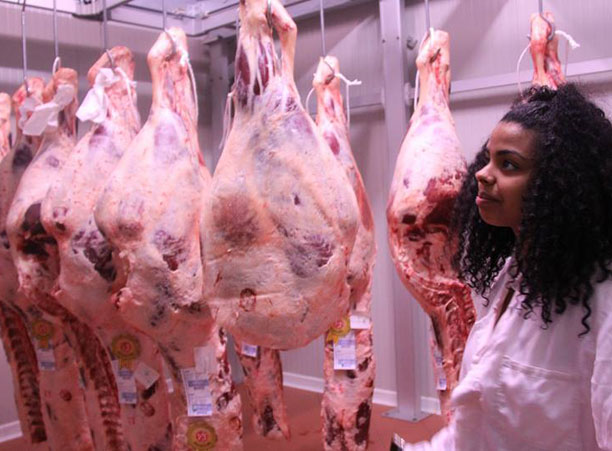 Adeline Gutierrez Nunez '19 admiring the meats of world famous butcher, Dario Cecchini. Image by Gina DeFloria ‘17
Adeline Gutierrez Nunez '19 admiring the meats of world famous butcher, Dario Cecchini. Image by Gina DeFloria ‘17Number of students: 14
Faculty: Andrea Borghini, associate professor of philosophy
Program Details: Situated in Panzano in Chianti, in Italy’s Tuscany region, students participated in an interactive course that provided hands on insight into the contemporary food world. Students took guided walks through the countryside, visited butchers, wineries, olive oil and cheese producers, as well as markets, restaurants, and specialty stores that produced items including chocolate and ice cream. In addition to studying the world of gastronomy in Tuscany, students even participated in cooking themselves, preparing four meals under expert guidance. Tuscany, which has a rich and varied gastronomic history and culture, was an ideal backdrop for students to engage with philosophical questions concerning the consumption, the production, and the labeling of foods, both globally and locally. Students also took trips to Viareggio and Florence while in Italy.
Highlights: “One of the coolest moment was when we visited Nittardi Winery, which used to be owned by Michelangelo Buonarroti in the 16th century.
“At Nittardi, we had a ‘wine blending’ competition. The students were divided into teams and as a group, we had to create a balanced blend from three types of wine: Petit Verdot, Merlot, and Cabernet Sauvignon. This exercise's goal was to test our understanding of wine composition and taste. After many trials and errors and trying to incorporate everyone’s opinions, my team was able to find a blend that suited our palate, and we submitted it. Even though we loved our blend, we did not have high expectations. We were ecstatic when we found out that our blend won.” – Maxime Nyugen ’18
Takeaway: “One thing I will try and bring back is my appreciation of the food process and I will be paying more attention to what I consume and where it comes from. Before this Maymester, I was consuming food ‘blindly,’ and I had very little idea of what I was eating and where it came from. After this Maymester, I started paying more attention to what I consume, and I would love if more people from Holy Cross would do the same. It is not only beneficial for each individual, but it is better for society as a whole. I believe we all can benefit from paying more attention to what we consume as a society.” – Gina DeFloria ’17
Central Europe
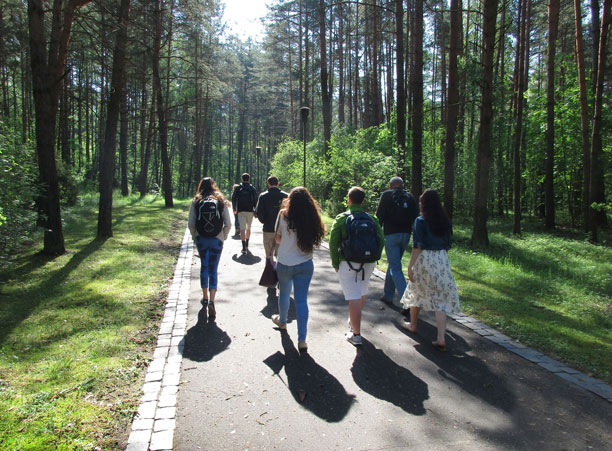 Students walk through Ponar Forest outside of Vilnius, Lithuania. The serene forest on a beautiful summer day stands in stark contrasts to the horrific bloodshed that occurred in the same place where tens of thousands of mostly women and children were murdered. Image by Dan Bitran
Students walk through Ponar Forest outside of Vilnius, Lithuania. The serene forest on a beautiful summer day stands in stark contrasts to the horrific bloodshed that occurred in the same place where tens of thousands of mostly women and children were murdered. Image by Dan BitranNumber of students: 10
Faculty: Daniel Bitran, professor of psychology and Thomas Doughton, senior lecturer for Center for Interdisciplinary Studies
Program Details: Across Central Europe, traveling to cities including Vilnius, Warsaw, Lublin, Krakow, Prague, and Berlin, students took a close look at how the Holocaust is memorialized. They visited former ghettos and Jewish heritage museums in these major cities and sites surrounding them, including labor camps and death camps. Through readings, photographic record, and other historical documents, students developed their understanding of the Holocaust, the Jewish culture before the war, and the individuals who were killed.
Highlights: “I would say that the biggest highlight of the trip was visiting Auschwitz, where we had comprehensive tour of Auschwitz, the main concentration camp and Auschwitz-Birkenau, the central death camp. I had heard about the notorious camp in different history classes, books, and movies, but actually visiting the concentration and death camp was quite the powerful experience.
“It was relatively well preserved, so I could certainly picture what it was like when it operated. Yet, it is difficult to fathom that this seemingly serene place full of tourists was so full of suffering and death just seventy years ago. I definitely acquired a better perspective of what the victims of Auschwitz experienced by visiting the camp, and realized that the history of the Auschwitz and the stories of its victims is way more extensive than what we are exposed to in high school or in movies.” – Joseph Cataldo ’18
Takeaway: “I was struck by just how differently the Holocaust was experienced in different regions of central Europe. There is no single-story of the Holocaust — Jewish communities in the Polish cities experienced the Holocaust differently from those in Lithuania, they from those imprisoned in the Terezín Camp in Czech Republic, and they from those in Berlin where it all began.
“Often in school, people are taught a single story of the Holocaust: six million Jews killed, gas chambers, Auschwitz, Hitler. Upon closer examination, we contextualized the extreme variety of Holocausts in central Europe from 1939-1945 during the Maymester, and my perspective on how Jewish communities throughout Central Europe experienced the Holocaust became deeply nuanced and expanded.
“I bring back a much deeper sense of human fragility, the human capacity to hope and persist, and a greater conviction in the importance of dialogue and tolerance in this increasingly hectic, divided world.” – Ryan Kingsley ’17
Moscow, Russia
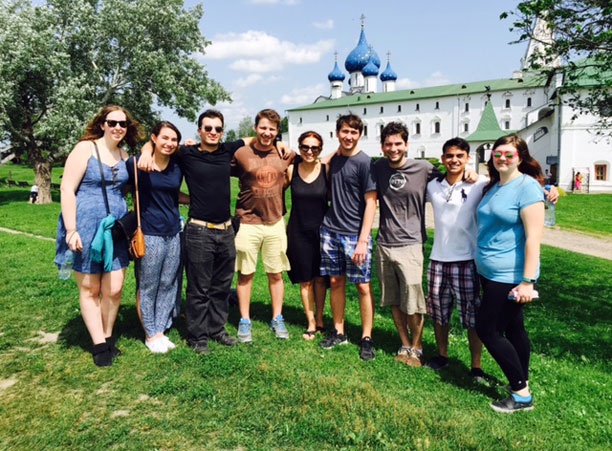 Students pose in the ancient city of Suzdal. Image by Olga Partan
Students pose in the ancient city of Suzdal. Image by Olga PartanNumber of students: 8
Faculty: Olga Partan, assistant professor of Russian
Program Details: This intensive language program offered students the opportunity to spend six weeks at the Russian State University for the Humanities in Moscow, where they improved their language skills through courses offered at varying levels of proficiency. Students’ immersive language experience was further supported through their everyday interaction with contemporary Russian life—its arts, culture, history, and politics. The program also included a number of trips to theatres, museums and churches in Moscow, in addition to visits outside the city to historic monasteries, Golden Ring towns, and the homes of Russia’s greatest writers.
Highlights: "I would say that the trip to St. Petersburg stands out as the most memorable part of the trip. It started off in a unique fashion — on an overnight train. Although a tight squeeze, the train was clean, the beds were comfortable, and we were able to have breakfast in bed while pulling into St. Petersburg. In only a few short days, Holy Cross was able to schedule a breadth of cultural excursions: the Hermitage, St. Isaac’s Cathedral, the St. Petersburg’s Krepost, a canal ride, a trip to Peter the Great’s palace at Petergof, and a trip to Catherine’s Palace in Tsarskoye Selo. The beauty and history contained in not only St. Petersburg but also the surrounding area cannot be expressed in words.” – Michael Morigi ’19
Takeaway: “I think my biggest takeaway from this program is that Russian isn't as intimidating as I thought it would be, and to simply make an effort in speaking the language, even though I sometimes felt like a fool, was essential in my learning.
“I bring back a new appreciation of Russian culture, better insight into the Russian perspective, and a few matroshka dolls.” – Sarah Baker ’19
Rome, Italy
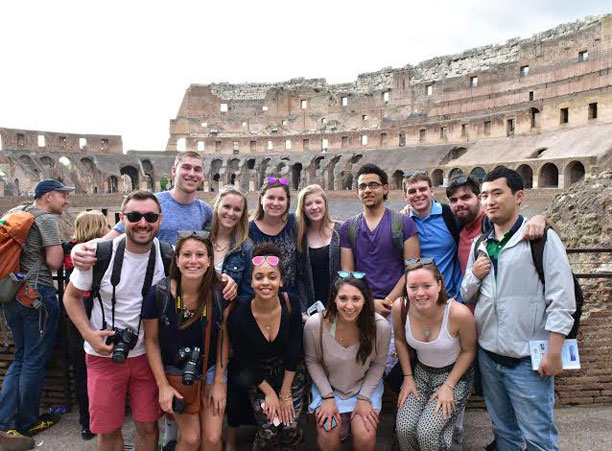 Students stand in the Colosseum. Image by Aaron Seider
Students stand in the Colosseum. Image by Aaron SeiderNumber of students: 19
Faculty: Aaron Seider, assistant professor of classics, and Thomas Martin, Jeremiah W. O'Connor Professor in classics
Program Details: Living in Rome for a month, students had the opportunity to study the city up close, exploring the topography and history of classical Rome and its evolution across centuries. They discussed artifacts at ancients sites such as the Roman Forum, Pantheon and Colosseum, looking at their historical and cultural contexts, and visited major sites of later centuries such as Villa Farnesina, St. Peter’s Basilica, and the Keats-Shelley Memorial House. From museums to archeological sites to renaissance palaces, students studied the coexistence of past and present in Rome. Additional excursions were taken outside the city to sites including Ostia, Castel Gandolfo, and Tivoli and Hadrian’s Villa.
Highlights: “Without question, the biggest highlight of the trip was the relationships I developed with my fellow Holy Cross classmates and the environment in which they developed. Getting to know people from each and every class year whom I otherwise may have never met made the trip unique. We shared a passion for learning about Roman culture, but the friendships went much further than a typical classroom face you recognize on campus.
“While structured very well, the trip allowed a lot of individuality and choice. A lot of the trip, such as getting places and picking where to eat, was left up to us as the students. Ultimately, we all had the same end goal and accomplished it, it was just up to the students to collaborate. My worries about not knowing people on the trip were quickly put to rest." – Luis Perez ’17
Takeaway: “My greatest takeaway is how important history is to a culture and the how much it still influences societies today. Especially with a history as long and a culture as evolved as the Romans, so much of the culture relies on things that happened decades and even centuries ago. Studying in Rome meant seeing architecture from an entirely different time period still standing, and how the Romans still pride themselves on their background and where they come from. Whether it was eating the food, or learning to speak the language at a beginner level, studying in Rome allowed a deeper appreciation of the culture than simply learning out of a book would have done.
“While the course was studying another culture, our professors constantly encouraged us to apply our knowledge to ourselves and our own cultures. By learning about ancient Rome, we were also learning skills about how to be self-reflective and to appreciate history and how much evolution the world has gone through to get to where it is today.” – Luis Perez ’17

